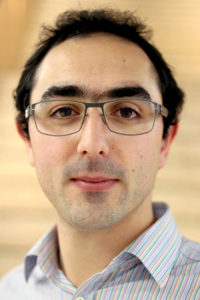This year, our partners the Institution of Chemical Engineers (IChemE), jointly awarded their Junior Moulton Medal to two sets of recipients for their respective works, both published in MSDE. The Junior Moulton Medal is awarded to the early-career author, or authors, of the most meritorious papers published by IChemE in the last year.
One set of this year’s recipients are Luke Forster, Le Yu and Carmine D’Agostino from the University of Manchester for their paper “Tailoring morphology of hierarchical catalysts for tuning pore diffusion behaviour: a rational guideline exploiting bench-top pulsed-field gradient (PFG) nuclear magnetic resonance (NMR)”.
 Luke Forster received his MChem at the University of Sheffield and is currently studying for a PhD in Chemical Engineering at the University of Manchester under the supervision of Dr. Carmine D’Agostino, working in the Catalysis & Porous Materials group. His current project involves the use of low-field NMR diffusion and relaxation measurements to investigate mass transport and adsorption processes in porous, surface functionalised catalytic materials in order to better explain their influence on catalytic activity and selectivity.
Luke Forster received his MChem at the University of Sheffield and is currently studying for a PhD in Chemical Engineering at the University of Manchester under the supervision of Dr. Carmine D’Agostino, working in the Catalysis & Porous Materials group. His current project involves the use of low-field NMR diffusion and relaxation measurements to investigate mass transport and adsorption processes in porous, surface functionalised catalytic materials in order to better explain their influence on catalytic activity and selectivity.
 Carmine D’Agostino received his BEng and MEng in Chemical Engineering at the Universita’ di Napoli “Federico II” and a PhD in Chemical Engineering at the University of Cambridge under the supervision of Prof. Lynn Gladden. He is currently a Lecturer in Chemical Engineering at The University of Manchester, working in the Catalysis & Porous Materials group. His research interests focus on investigating diffusion, dynamics and adsorption of complex fluids and fluids within porous structures and catalysts using spectroscopic techniques, including high-field and low-field NMR. He received several awards, including the Young Scientist Award at the International Conference on Catalysis, the Reaction Chemistry & Engineering Emerging Investigator and a prestigious Junior Research Fellowship from Wolfson College, University of Cambridge.
Carmine D’Agostino received his BEng and MEng in Chemical Engineering at the Universita’ di Napoli “Federico II” and a PhD in Chemical Engineering at the University of Cambridge under the supervision of Prof. Lynn Gladden. He is currently a Lecturer in Chemical Engineering at The University of Manchester, working in the Catalysis & Porous Materials group. His research interests focus on investigating diffusion, dynamics and adsorption of complex fluids and fluids within porous structures and catalysts using spectroscopic techniques, including high-field and low-field NMR. He received several awards, including the Young Scientist Award at the International Conference on Catalysis, the Reaction Chemistry & Engineering Emerging Investigator and a prestigious Junior Research Fellowship from Wolfson College, University of Cambridge.
Read their Junior Moulton Medal winning paper “Tailoring morphology of hierarchical catalysts for tuning pore diffusion behaviour: a rational guideline exploiting bench-top pulsed-field gradient (PFG) nuclear magnetic resonance (NMR)”. This article is part of our collection MSDE for the 2021 MSDE Symposium and all articles are FREE to read until 15 July.
Group leader Carmine D’Agostino has kindly answered some questions for us.
Your Moulton Medal winning paper focuses on tailoring textural properties of catalysts to tune their transport properties. In your opinion, what are the most important questions to be asked/answered in this field of research?
Catalyst design is crucial for enabling a large number of chemical processes. One aspect that is often overlooked, yet very important for the industrial applications of catalytic materials, is the ability to tune mass transport within the porous matrix of the catalyst and how this is related to the final morphology of the material, which is in turn related to the manufacturing process. Whilst this aspect is marginally discussed in the literature for laboratory scale catalysts, we noted that for catalysts prepared on an industrial scale not much was reported in this area.
In our work together with the company Haldor Topsøe, one of the key international players in catalyst manufacturing, we provide a clear relationship between catalyst preparation methods on a large scale, pore morphology and its effect on internal mass transport by diffusion, setting a rational guideline for tuning pore diffusivity by acting on the conditions used in the manufacturing process of catalytic materials, particularly important to industrial manufacturers. In addition, we do so using newly developed, bench-top NMR instruments, which unlike traditional and expensive high-field superconductive magnets, are much more affordable, compact and hence can easily be easily placed in industrial R&D labs.
What aspect of your work are you most excited about at the moment?
Low-field, bench-top NMR is a relatively new development in the area of NMR diffusion measurements and it is generally regarded as a tool with several limitations compared to high-field instruments. However, in our work we were able to show that these instruments are able to probe and quantify diffusion in industrially relevant samples, providing data of excellent quality. We are excited about demonstrating the ability of such instruments to reveal new insights into such complex industrial productions and we hope that our work will contribute to further develop the set of tools available in catalysis R&D labs, looking at aspects that have so far been overlooked, such as that of transport-morphology-synthesis relationship.
What do you find most challenging about your research?
As highlighted above, unlike conventional high-field NMR instruments, the use of low-field bench-top NMR presents some technical limitations. In addition, the use of real-world catalyst materials adds additional challenges as often these materials can contain impurities, which may affect the quality of the data and their interpretation. Hence, optimisation of experimental set-up and careful data analysis and interpretation need a particular attention.
In which upcoming conferences or events (online or in person) may our readers meet you?
We will be presenting this work online as a poster at the 15th International Conference on Materials Chemistry (12/07/21 – 15/07/21). Additionally, we will be giving presentations on this work at the 2021 MSDE Symposium for the RSC which will feature the Emerging Investigator community (17/06/21 – 18/06/21), which will be free to attend to all. Finally, we will be accepting our award at an online ceremony and webinar organised by the IChemE which is yet to have a date set and we will be giving a presentation of the award winning work there. We look forward to meeting as many people as possible and discussing this work with them!
Register before for FREE 3 June for the 2021 MSDE Symposium!














